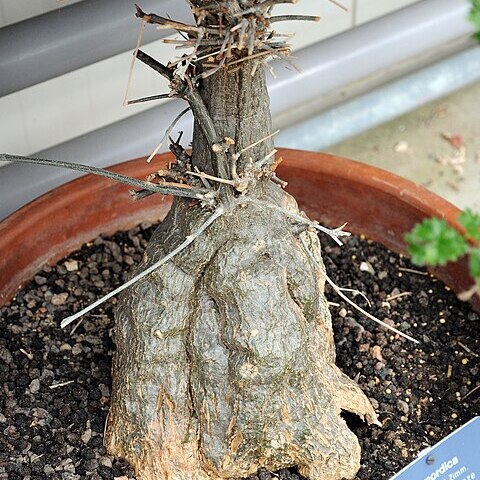Climber to 7 m.; rootstock tuberous, visible above ground and tapering upwards into the stems, dark green or brownish with scattered paler lenticels, longitudinally sulcate, 15–20 cm. across.. Young stems green, herbaceous, glabrous except for hair-tufts at the nodes, soon becoming woody with smooth or slightly rough grey or brownish bark; basal stems thickened.. Leaves pedately biternately (5–7–)9(–12)-foliolate, deciduous; terminal leaflet elliptic, ovate or suborbicular, equal-sided and cuneate, slightly apiculate, sinuate-toothed or dentate, 11–47 mm. long, 10–28 mm. broad; lateral leaflets somewhat smaller, tending to be rather more rounded and somewhat unequal-based; central rhachis longer than petiole, 6–31 mm. long; petiolules up to 13 mm. long; petiole 2.5–25 mm. long.. Tendrils simple.. Dioecious.. Male flowers 1–14, subumbellate on a 4–100 mm. long glabrous or pubescent peduncle and immediately subtended by a small pale green white-pubescent 1–3 mm. in diameter (rarely up to 7–10 mm. long and 10–12 mm. broad) bract; peduncles on current stems or produced in clusters at the nodes on old leafless stems, the flowering stems often practically leafless and with reduced internodes and then giving the appearance of a fasciculate inflorescence; pedicels white-pubescent, 2–13 mm. long; receptacle-tube brownish-green, broadly campanulate, 2–2.5 mm. long; lobes subulate-triangular to rounded-triangular, 2–4 mm. long, pale green, hairy at the margins; petals oblong-lingulate, rounded and slightly apiculate, 7–13 mm. long, 4–8 mm. broad, recurved in upper third, rich orange-yellow, 3 with a dark greenish-to brownish-purple basal patch, 2 with incurved scales inside at the base; stamens (fig. 2/6a, 6b, p. 18) 3; thecae triplicate.. Female flowers solitary (rarely paired), subsessile, minutely bracteate; ovary 12–14 mm. long, 2.5–3 mm. across, with 8 slight longitudinal ridges; receptacle-tube shallow; lobes triangular-lanceolate, ± 1.5–2 mm. long; petals ± 8 mm. long and 4 mm. broad.. Fruit on a 2–15 mm. long stalk, ovoid and beaked, 31–70 mm. long, 15–30 mm. across, subterete or with 8 slight longitudinal ridges or angles, bright red.. Seeds when fresh enclosed in pockets of yellowish pulp, broadly ovate in outline, blackish-brown, 14 × 10 × 2.5 mm.; testa sculptured; margins grooved.
More
A herb. It lies along the ground or can be climbing. It has tendrils. It has a fleshy rootstock. The stems can be 7 m long and become woody. The leaves are alternate. They have about 9 lobes. The central leaflet is almost round and 1-5 cm long by 1-3 cm wide and the side leaflets are smaller. Male and female flowers are separate. Male flowers are in groups and female flowers occur singly. The fruit are oval berries. They are 3-7 cm long and 2-3 cm wide. The pulp is bright red with many seeds.

